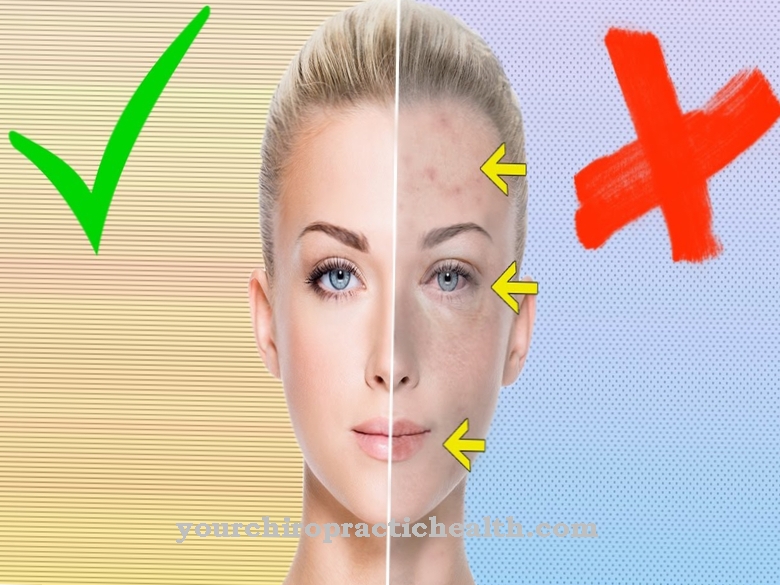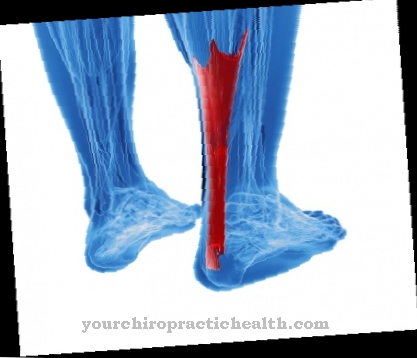Of the Melanin deficiency is characterized by a lighter coloration of the skin, which can appear all over the body or even just in spots. The causes of the disease are diverse and a precise anamnesis is required to clarify this. In general, however, the melanin deficiency is almost always harmless, but it can be a major emotional burden for those affected.
What is Melanin Deficiency?

© shurkin_son - stock.adobe.com
Melanin deficiency, medical Hypomelanosis called, is a pigment disorder of the skin that is due to a lack of melanocytes.
The melanocytes found in the upper skin, also called the epidermis, are responsible for the formation of melanin, which on the one hand gives the skin its natural color and on the other hand protects the deeper layers of the skin from harmful UV radiation. The melanocytes are either activated by UV light or by the melanocyte-stimulating hormone, short MSH, also called melanotropin, which in both cases results in melanin synthesis and the formation of melanosomes.
With a widespread melanin deficiency, the skin on the entire body is lighter than usual, with a localized melanin deficiency it shows light spots. If the melanin is completely absent, such as in complete albinism, one speaks of depigmentation.
causes
The causes for one Melanin deficiency can be of the most varied types and have not yet been fully clarified in detail. However, the number of melanocytes in the epidermis is always decisive. The fewer melanocytes there are, the less melanin can be produced by the body and the lighter the skin appears.
In the so-called white spot disease, a localized melanin deficiency, it is now assumed that an autoimmune reaction leads to destruction of the melanocytes in the epidermis. Other causes for the destruction of melanocytes, which are also expressed in a stain-like form, can be x-ray examinations or cosmetics. Heat or cold, for example also therapeutically induced, such as cryotherapy, a special form of cold therapy that is used, among other things, for rheumatism, can destroy the melanocytes.
Drugs that affect hormonal metabolism, such as birth control pills, can also trigger a melanin deficiency. In addition, toxins and inflammation of the epidermis, such as psoriasis or neurodermatitis, are also possible causes of melanin deficiency.
Symptoms, ailments & signs
A melanin deficiency is initially expressed by the characteristic pigmentation disorder of the skin. In the affected region, the skin appears unusually light or dark, with the areas of the skin being sharply demarcated and mostly appearing over a large area on the face, shoulders and arms or on the neck. Depending on the type and severity of the deficiency symptoms, the pigment disorders can turn out very differently.
A slight melanin deficiency manifests itself in isolated patches of skin, while a severe deficiency can cause extensive skin changes. It is typical of the pigment spots that they do not change color when exposed to sunlight. Instead, UV rays quickly redden the pigment spots and ultimately lead to sunburn. If white spot disease is the cause, the spots increase in size and number in the long term.
The conspicuous areas of skin are accompanied by premature graying of the hair, nail changes and occasionally changes in the color of the eyes. If the melanin deficiency is based on albinism, ametropia can occur. In addition, there is an increased sensitivity to sunlight, which manifests itself in recurring sunburns and severe discomfort in the sun.
The risk of skin cancer is greatly increased with a melanin deficiency. The disease is also often associated with psychological complaints such as depression or anxiety.
Diagnosis & course
Diagnostic stands for one Melanin deficiency Above all, the patient's extensive anamnesis is in the foreground, in order to rule out possible hereditary diseases or a melanin deficiency induced by drugs or medical treatments.
The patient's entire medical history can be important in determining the cause of the melanin deficiency. Under certain circumstances, a biopsy of one of the affected parts of the house can reveal something about the background of the melanin deficiency.
The course of the disease is mostly harmless and only progresses slowly. In white spot disease, the spots become larger in the course of life and often also increase in number, but this is not a cause for concern in relation to the skin.
Complications
A melanin deficiency can lead to some complications. Depending on the cause, a lack of melanin usually makes the skin more sensitive to light. This increases the risk of sunburn and serious skin diseases. A melanin deficiency as a result of albinism or white spot disease is associated with an increased risk of skin cancer.
In addition, the eyes are oversensitive and become ill more often in the course of life. A melanin deficiency often also represents an emotional burden. The stains that occur frequently are viewed by those affected as cosmetic flaws, which can lead to a decrease in self-esteem. White spot disease in particular can be stressful for those affected, as the spots enlarge and increase in number over the course of life.
The stress is increased by the accelerated graying of the hair and faster skin aging. Complications can also arise when treating melanin deficiency. Ampoules and nasal sprays containing the active ingredient Melanotan are suspected of damaging the cardiovascular system and the digestive tract. Serious skin damage and allergic reactions can also occur. Similar risks arise from dietary supplements and vitamin preparations, which are often used in cases of melanin deficiency.
When should you go to the doctor?
People who have pale skin or white spots on the skin should consult a doctor to clarify the cause. A noticeably light skin is an indication of a lack of nutrients in the organism, which, if left untreated, leads to an increase in symptoms. Spots or pigmentation disorders are signs of an existing irregularity that needs investigation and treatment. They can appear on the entire body and are present in a different form in every patient. A doctor's visit is necessary as soon as the skin changes spread to the body or the affected areas enlarge.
If the person has swelling, pain, or is very susceptible to sunburn, they should see a doctor. A special feature of a melanin deficiency is the constant paleness of the pigment spots despite exposure to the sun. Those affected often complain of a decrease in well-being when they are in the sun. If they are particularly sensitive to sunlight, a doctor is required to clarify the cause. If, in addition to the physical complaints, there are also emotional peculiarities, a doctor should be consulted. Behavioral problems, an aggressive appearance or withdrawal from the social environment are considered signs of an existing health problem. A doctor's visit is necessary so that countermeasures can be initiated.
Treatment & Therapy
The therapy of a Melanin deficiency depends on the cause of the same. If the deficiency is medication-related, it is necessary to discontinue the medication and find a replacement. In the case of cosmetics, the future avoidance of the product goes without saying.
If the melanin deficiency weighs too heavily on the soul, psychological therapy is advisable. Otherwise, in the case of a localized melanin deficiency in the form of spots, a purely cosmetic therapy is recommended to match the spots to the rest of the skin and to strengthen self-esteem again.
Irradiation of the affected areas of the skin is also often used for white spot disease and other blotchy occurrences of melanin deficiency. The therapy is usually of a long duration and has to be carried out regularly for months.
To stimulate the production of melanin in the body, the authors recommend Russel J. Reiter and Jo Robinson in their book "Melanin". The new weapon against old age and disease ”to take 100 milligrams of nicotinamide, 1000 milligrams of calcium and 500 milligrams of magnesium in the evening and 25 to 50 milligrams of vitamin B6 in the morning as a dietary supplement. However, there are no reliable studies on this.
Outlook & forecast
The prognosis for a melanin deficiency is generally favorable. In most cases there are no further physical impairments due to the lack of melanoma cells. In everyday life, greater attention should be paid to certain risk factors such as the influence of sunlight in order to improve overall health. Otherwise, consequential disorders are to be expected, which lead to a worsening of the situation.
If the person concerned takes sufficient consideration of their increased sensitivity to solar radiation, no further irregularities on the physical level are to be expected. Without this behavior, however, changes in the complexion of the skin and a deterioration in wellbeing can occur. If the disease progresses very unfavorably, the risk of developing skin cancer is increased without adequate consideration and protection from sunlight. This represents a potential threat to human life and, if left untreated, leads to premature death.
When making a prognosis, it should also be taken into account that the lack of melanin leads to visual abnormalities. This can trigger states of emotional stress, as the visual flaw is perceived by many affected as unpleasant. Under unfavorable conditions, a mental disorder develops. This must be taken into account when making a prognosis, as it has a significant negative effect on the overall condition of the person concerned.
prevention
Especially in the case of depigmentation, those affected are advised to use preventive sun protection products with a high sun protection factor, since in this case the UV light can penetrate into the deeper layers of the skin completely unhindered and the risk of skin cancer increases accordingly. Visiting the solarium is generally not advisable if you have any form of melanin deficiency.
Aftercare
Due to the lack of melanin, the skin of those affected usually becomes more sensitive to light, which means consciously staying away from excessive solar radiation during aftercare. The risk of skin cancer, sunburns and other serious illnesses increases and hypersensitivity of the eyes should also be countered with adequate protection. There are also spots on the skin of the sick, causing mental disorders and general emotional distress. The self-esteem of sufferers decreases as the spots are seen as a cosmetic blemish. Follow-up care also includes dealing confidently with the disease.
You can do that yourself
If the harmless white spot disease, a form of melanin deficiency, occurs, the person affected should take care to protect the parts of the body that are affected, especially from the sun. Sunscreen with a high sun protection factor should be used regularly before going outdoors.
In the severe form of melanin deficiency, albinism, great care must be taken to protect the skin and eyes from the sun. It is best not to stay outside when there is high solar radiation. Clothing that protects against UV rays is very important. It is also advisable to wear a hat and sunglasses and to use sunscreen.
The melanin deficiency can often be seen in the affected person. This can lead to psychological stress. Because of this, psychological support from a therapist or psychologist and / or participation in a self-help group for the respective form of the disease is advisable. It can improve the life of the person affected by making contact with other affected persons or by being accompanied by a trained person. This also counteracts the development of depression. In the case of white spot disease, cosmetic treatment of the affected areas can also improve the patient's emotional state.
























.jpg)



